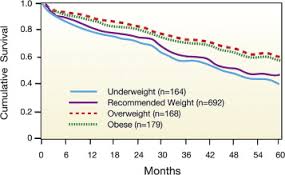
- posted: Mar. 31, 2015
THE OBESITY PARADOX: HEALTHY WITH MORE WEIGHT?
Dr. Jon Repole, D.C., N.C., H.H.P., C.P.T.
Research since the late 90's has consistently shown that the overweight and mildly obese live longer when compared to individuals of "healthy weight." This phenomenon is know as the Obesity paradox. It states that the overweight and mildly obese (assessed through BMI or Body Mass Index which is a measure of your height to weight) have lower all-cause mortality rates than those of normal body weight or BMI with the same health conditions. This phenomenon is not found however, in the moderately or severely obese.

So, how can this be? And, what does it mean?
There are many factors and hypotheses but the most grounded explanation and the one with the greatest consensus is -- not that the overweight are doing so well but the lean are doing so bad!
The key factor may be fitness. For example, those people with higher fitness (exercising 3-5 times a week) and increased weight may be more protected from chronic diseases than individuals of lower fitness status ("the couch potato") and normal body weight.
Other explanations to account for these findings is simply that increased weight also means increased muscle mass in those who are individually fit. Muscle mass, in general, can be a good predictor of general aging in "healthy"'individuals who have earned their muscle mass through appropriate means. Yet still another consideration is the status of your cardio-metabolic profile such as blood lipids (cholesterol), glucose levels, blood pressure, and insulin stores. Individuals with dysfunctions in the aforementioned profile along with lean weight are more at risk for all disease mortality than individuals with a healthy cardio-metabolic profile who are slightly overweight.
So don't be fooled into thinking that you should add excess weight to be healthy!
The key take home is NOT to rely on just one bio-marker to assess your overall health -- there are too many compounding factors. In fact, it may be found that increased happiness and being overweight is more protective than lean weight and depression. 
The researcher, I believe, helps us to shift our mental attention away from those extra 5-15 pounds of stubborn weight loss towards concentrating on cardiovascular fitness and muscle strengthening as a stronger predictor of disease progression than the outdated reliance on just BMI.
In fact, there are many types of "weight" or "fat" that should be assessed including:
- Difference between visceral fat (the kind found around your organs and easily assessed by measuring your hip/waist ratio) vs. superficial subcutaneous fat (the kind under your arm). Visceral fat is more dangerous and associated with increased mortality and progression of disease than fat found, for example, under your arm.
- Toxic fat (which is the amount of toxins being stored in fat tissue). When there is a toxin overload, the body stores these toxins in fat tissue to "deal with" them on a rainy day when the liver can handle the abuse! With higher concentrations of toxins, fat tissue will, in turn, produce more inflammatory mediators into the blood stream and hold onto the toxins (and the weight) for fear that the body will not be able to eliminate them from the body due to declining antioxidant levels (decreases in fruit and veggie consumption, for example).
- BMI (tells us the combined, undifferentiated information on fat and muscle) vs. Body Composition (which is specialized analysis that separates: body fat, muscle mass, water weight. Body composition is more helpful to distinguish the breakdown of weight.
In conclusion, next time you weigh yourself, remember there is more to the story than just the NUMBER!
Considerations that should be added to the new paradigm should include:
- overall stress levels
- happiness quotient
- cardio-metabolic profile (lipids, blood pressure, etc.)
- weight differentiation using body composition (to see muscle mass)
- assessing location of fat (visceral vs. subcutaneous)
- toxicity status (toxins are stored in fat tissue)
- fitness status
- AND MORE!
QUICK AND RELIABLE WAY TO ASSESS FITNESS STATUS
 According to the New England Journal of Medicine, your heart recovery rate which is the speed at which your pulse returns to normal after exercising is a superior indicator of general fitness status. People who have quick recovery rates live longer than those whose recovery rates are slower.
According to the New England Journal of Medicine, your heart recovery rate which is the speed at which your pulse returns to normal after exercising is a superior indicator of general fitness status. People who have quick recovery rates live longer than those whose recovery rates are slower.
How to Calculate:
Step 1: Perform any exercise at your target heart rate calculated as: (220-age) * (.75). For example, a person who is 30 years old would calculate their target heart rate at (220-30) * (.75) = 142bpm. The length of time you perform the exercise is not important -- choose an exercise program that you will be performing often so you can track your progress over time.
Step 2: Take your pulse immediately after your exercise. (Pulse 1)
Step 3: Sit quietly after completing your exercise for 2 minutes.
Step 4: Take your pulse once again. (Pulse 2)
Step 5: Subtract (Pulse 1 - Pulse 2)
If the difference between the two numbers is:
- Less than 22: Your biological age is slightly older than your calendar age.
- 22-52: Your biological age is about the same as your calendar age.
- 53-58: Your biological age is slightly younger than your calendar age.
- 59-65: Your biological age is moderately younger than your calendar age.
- 66 or more: Your biological age is a lot younger than your calendar age.
References
Diabetes Care August 2013 vol. 36 no. Supplement 2 S276-S281
J Sports Sci. 2011 May;29(8):773-82. doi: 10.1080/02640414.2011.553965.
http://www.enhancedmedicalcare.com/2013/01/20/improve-heart-health-by-knowing-your-recovery-heart-rate/
Locations
Jacksonville Location
9957 Moorings Drive, Suite 403
Jacksonville, FL 32257, US
HOURS OF OPERATION
9:00 am - 6:00 pm
9:00 am - 6:00 pm
9:00 am - 6:00 pm
9:00 am - 6:00 pm
9:00 am - 6:00 pm
Closed
Closed

